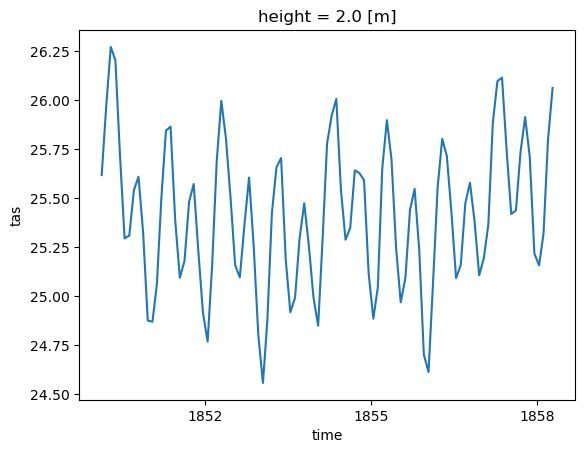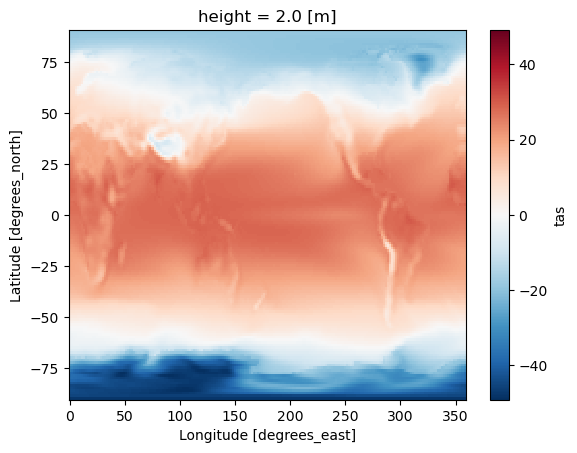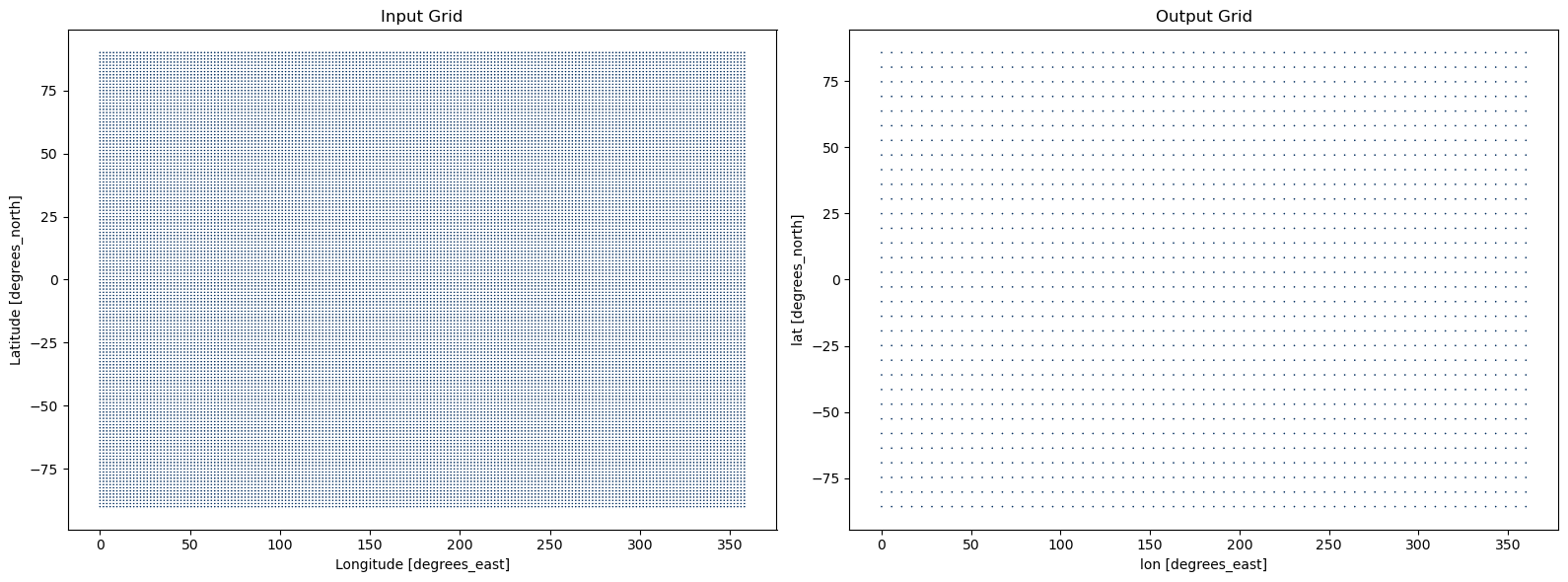
A Gentle Introduction to xCDAT (Xarray Climate Data Analysis Tools)#
“A Python package for simple and robust climate data analysis.”
Core Developers: Tom Vo, Stephen Po-Chedley, Jason Boutte, Jill Zhang, Jiwoo Lee
With thanks to Peter Gleckler, Paul Durack, Karl Taylor, and Chris Golaz
This work is performed under the auspices of the U. S. DOE by Lawrence Livermore National Laboratory under contract No. DE-AC52-07NA27344.
Notebook Setup#
Create an Anaconda environment for this notebook using the command below, then select the kernel in Jupyter.
conda create -n xcdat_notebook -c conda-forge python xarray netcdf4 xcdat xesmf matplotlib nc-time-axis jupyter
xesmfis required for horizontal regridding with xESMFmatplotlibis an optional dependency required for plotting with xarraync-time-axisis an optional dependency required formatplotlibto plotcftimecoordinates
Presentation Overview#
Intended audience: Some or no familiarity with xarray and/or xcdat
Driving force behind xCDAT
Goals and milestones of CDAT’s successor
Introducing xCDAT
Understanding the basics of Xarray
How xCDAT extends Xarray for climate data analysis
Technical design philosophy and APIs
Demo of capabilities
How to get involved
The Driving Force Behind xCDAT#
The CDAT (Community Data Analysis Tools) library has provided a suite of robust and comprehensive open-source climate data analysis and visualization packages for over 20 years
A driving need for a modern successor
Focus on a maintainable and extensible library
Serve the needs of the climate community in the long-term


Goals and Milestones for CDAT’s Successor#
Offer similar core capabilities
For example geospatial averaging, temporal averaging, and regridding
Use modern technologies in the library’s stack
Support parallelism and lazy operations
Be maintainable, extensible, and easy-to-use
Python Enhancement Proposals (PEPs)
Automate DevOps processes (unit testing, code coverage)
Actively maintain documentation
Cultivate an open-source community that can sustain the project
Encourage GitHub contributions
Community engagement efforts (e.g., Pangeo, ESGF)
Introducing xCDAT#
xCDAT is an extension of xarray for climate data analysis on structured grids
Goal of providing features and utilities for simple and robust analysis of climate data
Jointly developed by scientists and developers from:
E3SM Project (Energy Exascale Earth System Model Project)
PCMDI (Program for Climate Model Diagnosis and Intercomparison)
SEATS Project (Simplifying ESM Analysis Through Standards Project)
Users around the world via GitHub



Before We Dive Deeper, Let’s Talk About Xarray#
Xarray is an evolution of an internal tool developed at The Climate Corporation
Released as open source in May 2014
NumFocus fiscally sponsored project since August 2018


Key Features and Capabilities in Xarray#
“N-D labeled arrays and datasets in Python”
Built upon and extends NumPy and pandas
Interoperable with scientific Python ecosystem including NumPy, Dask, Pandas, and Matplotlib
Supports file I/O, indexing and selecting, interpolating, grouping, aggregating, parallelism (Dask), plotting (matplotlib wrapper)
Supported formats include: netCDF, Iris, OPeNDAP, Zarr, and GRIB
Source: https://xarray.dev/#features
Why use Xarray?#
“Xarray introduces labels in the form of dimensions, coordinates and attributes on top of raw NumPy-like multidimensional arrays, which allows for a more intuitive, more concise, and less error-prone developer experience.”
—https://xarray.pydata.org/en/v2022.10.0/getting-started-guide/why-xarray.html
Apply operations over dimensions by name
x.sum('time')
Select values by label (or logical location) instead of integer location
x.loc['2014-01-01']orx.sel(time='2014-01-01')
Mathematical operations vectorize across multiple dimensions (array broadcasting) based on dimension names, not shape
x - y
Easily use the split-apply-combine paradigm with groupby
x.groupby('time.dayofyear').mean().
Database-like alignment based on coordinate labels that smoothly handles missing values
x, y = xr.align(x, y, join='outer')
Keep track of arbitrary metadata in the form of a Python dictionary
x.attrs
Source: https://docs.xarray.dev/en/v2022.10.0/getting-started-guide/why-xarray.html#what-labels-enable
The Xarray Data Models#
“Xarray data models are borrowed from netCDF file format, which provides xarray with a natural and portable serialization format.”
—https://docs.xarray.dev/en/v2022.10.0/getting-started-guide/why-xarray.html
``xarray.Dataset``
A dictionary-like container of DataArray objects with aligned dimensions
DataArray objects are classified as “coordinate variables” or “data variables”
All data variables have a shared union of coordinates
Serves a similar purpose to a
pandas.DataFrame
``xarray.DataArray``
A class that attaches dimension names, coordinates, and attributes to multi-dimensional arrays (aka “labeled arrays”)
An N-D generalization of a
pandas.Series

Exploring the Xarray Data Models#
Example dataset: tas_Amon_ACCESS-ESM1-5_historical_r10i1p1f1_gn_185001-201412.nc
Open up this real dataset from ESGF using xarray’s OPeNDAP support.
Contains the
tasvariable (near-surface air temperature) recorded on a monthly frequency
It is not downloaded until calculations/computations are performed on the
DatasetobjectExample of an xarray lazy operation
[1]:
# This style import is necessary to properly render Xarray's HTML output with
# the Jupyer RISE extension.
# GitHub Issue: https://github.com/damianavila/RISE/issues/594
# Source: https://github.com/smartass101/xarray-pydata-prague-2020/blob/main/rise.css
from IPython.core.display import HTML
style = """
<style>
.reveal pre.xr-text-repr-fallback {
display: none;
}
.reveal ul.xr-sections {
display: grid
}
.reveal ul ul.xr-var-list {
display: contents
}
</style>
"""
HTML(style)
[1]:
[2]:
import xarray as xr
filepath = "https://esgf-data1.llnl.gov/thredds/dodsC/css03_data/CMIP6/CMIP/CSIRO/ACCESS-ESM1-5/historical/r10i1p1f1/Amon/tas/gn/v20200605/tas_Amon_ACCESS-ESM1-5_historical_r10i1p1f1_gn_185001-201412.nc"
ds = xr.open_dataset(filepath)
The Dataset Model#
[3]:
ds
[3]:
<xarray.Dataset>
Dimensions: (time: 1980, bnds: 2, lat: 145, lon: 192)
Coordinates:
* time (time) datetime64[ns] 1850-01-16T12:00:00 ... 2014-12-16T12:00:00
* lat (lat) float64 -90.0 -88.75 -87.5 -86.25 ... 86.25 87.5 88.75 90.0
* lon (lon) float64 0.0 1.875 3.75 5.625 ... 352.5 354.4 356.2 358.1
height float64 ...
Dimensions without coordinates: bnds
Data variables:
time_bnds (time, bnds) datetime64[ns] ...
lat_bnds (lat, bnds) float64 ...
lon_bnds (lon, bnds) float64 ...
tas (time, lat, lon) float32 ...
Attributes: (12/48)
Conventions: CF-1.7 CMIP-6.2
activity_id: CMIP
branch_method: standard
branch_time_in_child: 0.0
branch_time_in_parent: 87658.0
creation_date: 2020-06-05T04:06:11Z
... ...
variant_label: r10i1p1f1
version: v20200605
license: CMIP6 model data produced by CSIRO is li...
cmor_version: 3.4.0
tracking_id: hdl:21.14100/af78ae5e-f3a6-4e99-8cfe-5f2...
DODS_EXTRA.Unlimited_Dimension: timeA dictionary-like container of labeled arrays (DataArray objects) with aligned dimensions.
Key properties:
dims: a dictionary mapping from dimension names to the fixed length of each dimension (e.g., {‘x’: 6, ‘y’: 6, ‘time’: 8})coords: another dict-like container of DataArrays intended to label points used in data_vars (e.g., arrays of numbers, datetime objects or strings)data_vars: a dict-like container of DataArrays corresponding to variablesattrs: dict to hold arbitrary metadata
Source: https://docs.xarray.dev/en/stable/user-guide/data-structures.html#dataset
The DataArray Model#
A class that attaches dimension names, coordinates, and attributes to multi-dimensional arrays (aka “labeled arrays”)#
Key properties:
values: a numpy.ndarray holding the array’s valuesdims: dimension names for each axis (e.g., (‘x’, ‘y’, ‘z’))coords: a dict-like container of arrays (coordinates) that label each point (e.g., 1-dimensional arrays of numbers, datetime objects or strings)attrs: dict to hold arbitrary metadata (attributes)
Source: https://docs.xarray.dev/en/stable/user-guide/data-structures.html#dataarray
[4]:
ds.tas
[4]:
<xarray.DataArray 'tas' (time: 1980, lat: 145, lon: 192)>
[55123200 values with dtype=float32]
Coordinates:
* time (time) datetime64[ns] 1850-01-16T12:00:00 ... 2014-12-16T12:00:00
* lat (lat) float64 -90.0 -88.75 -87.5 -86.25 ... 86.25 87.5 88.75 90.0
* lon (lon) float64 0.0 1.875 3.75 5.625 7.5 ... 352.5 354.4 356.2 358.1
height float64 ...
Attributes:
standard_name: air_temperature
long_name: Near-Surface Air Temperature
comment: near-surface (usually, 2 meter) air temperature
units: K
cell_methods: area: time: mean
cell_measures: area: areacella
history: 2020-06-05T04:06:10Z altered by CMOR: Treated scalar dime...
_ChunkSizes: [ 1 145 192]Resources for Learning Xarray#
Here are some highly recommended resources:
xCDAT Extends Xarray for Climate Data Analysis#
Some key xCDAT features are inspired by or ported from the core CDAT library
e.g., spatial averaging, temporal averaging, regrid2 for horizontal regridding
Other features leverage powerful libraries in the xarray ecosystem
xESMF for horizontal regridding
xgcm for vertical interpolation
CF-xarray for CF convention metadata interpretation
xCDAT strives to support datasets CF compliant and common non-CF compliant metadata (time units in “months since …” or “years since …”)
Inherent support for lazy operations and parallelism through xarray + dask



The Technical Design Philosophy#
Streamline the user experience of developing code to analyze climate data
Reduce the complexity and overhead for implementing certain features with xarray (e.g., temporal averaging, spatial averaging)
Encourage reusable functionalities through a single library
Leveraging the APIs#
xCDAT provides public APIs in two ways:
Top-level APIs functions
e.g.,
xcdat.open_dataset(),xcdat.center_times()Usually for opening datasets and performing dataset level operations
Accessor classes
xcdat provides
Datasetaccessors, which are implicit namespaces for custom functionality.Accessor namespaces clearly identifies separation from built-in xarray methods.
Operate on variables within the
xr.Datasete.g.,
ds.spatial,ds.temporal,ds.regridder
xcdat spatial functionality is exposed by chaining the .spatial accessor attribute to the xr.Dataset object.
Key Features in xCDAT#
Feature | API | Description |
Extend |
|
|
Temporal averaging |
|
|
Geospatial averaging |
|
|
Horizontal regridding |
|
|
Vertical regridding |
|
|
A Demo of xCDAT Capabilities#
Prerequisites
Installing
xcdatImport
xcdatOpen a dataset and apply postprocessing operations
Scenario 1 - Calculate the spatial averages over the tropical region
Scenario 2 - Calculate the annual anomalies
Scenario 3 - Horizontal regridding (bilinear, gaussian grid)
Installing xcdat#
xCDAT is available on Anaconda under the conda-forge channel (https://anaconda.org/conda-forge/xcdat)
Two ways to install xcdat with recommended dependencies (xesmf):
Create a conda environment from scratch (
conda create)conda create -n <ENV_NAME> -c conda-forge xcdat xesmf conda activate <ENV_NAME>
Install
xcdatin an existing conda environment (conda install)conda activate <ENV_NAME> conda install -c conda-forge xcdat xesmf
If you’re working on HPC, we have a guide for that too!
Source: https://xcdat.readthedocs.io/en/latest/getting-started.html
Opening a dataset#
Example dataset: tas_Amon_ACCESS-ESM1-5_historical_r10i1p1f1_gn_185001-201412.nc (same as before)
[5]:
# This gives access to all xcdat public top-level APIs and accessor classes.
import xcdat as xc
# We import these packages specifically for plotting. It is not required to use xcdat.
import matplotlib.pyplot as plt
import pandas as pd
filepath = "https://esgf-data1.llnl.gov/thredds/dodsC/css03_data/CMIP6/CMIP/CSIRO/ACCESS-ESM1-5/historical/r10i1p1f1/Amon/tas/gn/v20200605/tas_Amon_ACCESS-ESM1-5_historical_r10i1p1f1_gn_185001-201412.nc"
ds = xc.open_dataset(
filepath,
add_bounds=True,
decode_times=True,
center_times=True
)
# Unit adjustment from Kelvin to Celcius.
ds["tas"] = ds.tas - 273.15
[6]:
ds
[6]:
<xarray.Dataset>
Dimensions: (time: 1980, bnds: 2, lat: 145, lon: 192)
Coordinates:
* time (time) object 1850-01-16 12:00:00 ... 2014-12-16 12:00:00
* lat (lat) float64 -90.0 -88.75 -87.5 -86.25 ... 86.25 87.5 88.75 90.0
* lon (lon) float64 0.0 1.875 3.75 5.625 ... 352.5 354.4 356.2 358.1
height float64 2.0
Dimensions without coordinates: bnds
Data variables:
time_bnds (time, bnds) object ...
lat_bnds (lat, bnds) float64 ...
lon_bnds (lon, bnds) float64 ...
tas (time, lat, lon) float32 -27.19 -27.19 -27.19 ... -25.29 -25.29
Attributes: (12/48)
Conventions: CF-1.7 CMIP-6.2
activity_id: CMIP
branch_method: standard
branch_time_in_child: 0.0
branch_time_in_parent: 87658.0
creation_date: 2020-06-05T04:06:11Z
... ...
variant_label: r10i1p1f1
version: v20200605
license: CMIP6 model data produced by CSIRO is li...
cmor_version: 3.4.0
tracking_id: hdl:21.14100/af78ae5e-f3a6-4e99-8cfe-5f2...
DODS_EXTRA.Unlimited_Dimension: timeScenario 1: Spatial Averaging#
Related accessor: ds.spatial
In this example, we calculate the spatial average of tas over the tropical region and plot the first 100 time steps.
[7]:
ds_trop_avg = ds.spatial.average("tas", axis=["X","Y"], lat_bounds=(-25,25))
ds_trop_avg.tas
[7]:
<xarray.DataArray 'tas' (time: 1980)>
array([25.24722608, 25.61795924, 25.96516235, ..., 26.79536823,
26.67771602, 26.27182383])
Coordinates:
* time (time) object 1850-01-16 12:00:00 ... 2014-12-16 12:00:00
height float64 2.0[8]:
ds_trop_avg.tas.isel(time=slice(1, 100)).plot()
[8]:
[<matplotlib.lines.Line2D at 0x14bdf2170>]

Scenario 2: Calculate temporal average#
Related accessor: ds.temporal
In this example, we calculate the temporal average of ``tas`` as a single snapshot (time dimension is collapsed).
[9]:
ds_avg = ds.temporal.average("tas", weighted=True)
ds_avg.tas
[9]:
<xarray.DataArray 'tas' (lat: 145, lon: 192)>
array([[-48.01481628, -48.01481628, -48.01481628, ..., -48.01481628,
-48.01481628, -48.01481628],
[-44.94085363, -44.97948214, -45.01815398, ..., -44.82408252,
-44.86273067, -44.9009281 ],
[-44.11875274, -44.23060624, -44.33960158, ..., -43.76766492,
-43.88593717, -44.00303006],
...,
[-18.21076615, -18.17513373, -18.13957458, ..., -18.32720478,
-18.28428828, -18.2486193 ],
[-18.50778243, -18.49301854, -18.47902819, ..., -18.55410851,
-18.5406963 , -18.52413098],
[-19.07366375, -19.07366375, -19.07366375, ..., -19.07366375,
-19.07366375, -19.07366375]])
Coordinates:
* lat (lat) float64 -90.0 -88.75 -87.5 -86.25 ... 86.25 87.5 88.75 90.0
* lon (lon) float64 0.0 1.875 3.75 5.625 7.5 ... 352.5 354.4 356.2 358.1
height float64 2.0
Attributes:
operation: temporal_avg
mode: average
freq: month
weighted: True[10]:
ds_avg.tas.plot(label="weighted")
[10]:
<matplotlib.collections.QuadMesh at 0x10cc641f0>

Scenario 3: Horizontal Regridding#
Related accessor: ds.regridder
In this example, we will generate a gaussian grid with 32 latitudes to regrid our input data to.
Create the output grid#
[11]:
output_grid = xc.create_gaussian_grid(32)
output_grid
[11]:
<xarray.Dataset>
Dimensions: (lat: 32, bnds: 2, lon: 65)
Coordinates:
* lat (lat) float64 85.76 80.27 74.74 69.21 ... -74.74 -80.27 -85.76
* lon (lon) float64 0.0 5.625 11.25 16.88 ... 343.1 348.8 354.4 360.0
Dimensions without coordinates: bnds
Data variables:
lat_bnds (lat, bnds) float64 90.0 83.21 83.21 77.61 ... -83.21 -83.21 -90.0
lon_bnds (lon, bnds) float64 -2.812 2.812 2.812 8.438 ... 357.2 357.2 362.8Plot the Input vs. Output Grid#
[12]:
fig, axes = plt.subplots(ncols=2, figsize=(16, 6))
input_grid = ds.regridder.grid
input_grid.plot.scatter(x='lon', y='lat', s=5, ax=axes[0], add_colorbar=False, cmap=plt.cm.RdBu)
axes[0].set_title('Input Grid')
output_grid.plot.scatter(x='lon', y='lat', s=5, ax=axes[1], add_colorbar=False, cmap=plt.cm.RdBu)
axes[1].set_title('Output Grid')
plt.tight_layout()

Regrid the data#
xCDAT offers horizontal regridding with xESMF (default) and a Python port of regrid2. We will be using xESMF to regrid.
[13]:
# xesmf supports "bilinear", "conservative", "nearest_s2d", "nearest_d2s", and "patch"
output = ds.regridder.horizontal('tas', output_grid, tool='xesmf', method='bilinear')
[14]:
fig, axes = plt.subplots(ncols=2, figsize=(16, 4))
ds.tas.isel(time=0).plot(ax=axes[0])
axes[0].set_title('Input data')
output.tas.isel(time=0).plot(ax=axes[1])
axes[1].set_title('Output data')
plt.tight_layout()

Parallelism with Dask#
Nearly all existing xarray methods have been extended to work automatically with Dask arrays for parallelism
—https://docs.xarray.dev/en/stable/user-guide/dask.html#using-dask-with-xarray
Parallelized xarray methods include indexing, computation, concatenating and grouped operations
xCDAT APIs that build upon xarray methods inherently support Dask parallelism
Dask arrays are loaded into memory only when absolutely required (e.g., decoding time, handling bounds)
High-level Overview of Dask Mechanics#
Dask divides arrays into many small pieces, called “chunks” (each presumed to be small enough to fit into memory)
Dask arrays operations are lazy
Operations queue up a series of tasks mapped over blocks
No computation is performed until values need to be computed (lazy)
Data is loaded into memory and computation is performed in streaming fashion, block-by-block
Computation is controlled by multi-processing or thread pool
Source: https://docs.xarray.dev/en/stable/user-guide/dask.html
How do I activate Dask with Xarray/xCDAT?#
The usual way to create a Dataset filled with Dask arrays is to load the data from a netCDF file or files
You can do this by supplying a
chunksargument toopen_dataset()or using theopen_mfdataset()functionBy default,
open_mfdataset()will chunk each netCDF file into a single Dask arraySupply the
chunksargument to control the size of the resulting Dask arraysXarray maintains a Dask array until it is not possible (raises an exception instead of loading into memory)
Source: https://docs.xarray.dev/en/stable/user-guide/dask.html#reading-and-writing-data
[15]:
filepath = "http://esgf.nci.org.au/thredds/dodsC/master/CMIP6/CMIP/CSIRO/ACCESS-ESM1-5/historical/r10i1p1f1/Amon/tas/gn/v20200605/tas_Amon_ACCESS-ESM1-5_historical_r10i1p1f1_gn_185001-201412.nc"
# Use .chunk() to activate Dask arrays
# NOTE: `open_mfdataset()` automatically chunks by the number of files, which
# might not be optimal.
ds = xc.open_dataset(
filepath,
chunks={"time": "auto"}
)
[16]:
ds
[16]:
<xarray.Dataset>
Dimensions: (time: 1980, bnds: 2, lat: 145, lon: 192)
Coordinates:
* time (time) object 1850-01-16 12:00:00 ... 2014-12-16 12:00:00
* lat (lat) float64 -90.0 -88.75 -87.5 -86.25 ... 86.25 87.5 88.75 90.0
* lon (lon) float64 0.0 1.875 3.75 5.625 ... 352.5 354.4 356.2 358.1
height float64 ...
Dimensions without coordinates: bnds
Data variables:
time_bnds (time, bnds) object dask.array<chunksize=(1980, 2), meta=np.ndarray>
lat_bnds (lat, bnds) float64 dask.array<chunksize=(145, 2), meta=np.ndarray>
lon_bnds (lon, bnds) float64 dask.array<chunksize=(192, 2), meta=np.ndarray>
tas (time, lat, lon) float32 dask.array<chunksize=(1205, 145, 192), meta=np.ndarray>
Attributes: (12/49)
Conventions: CF-1.7 CMIP-6.2
activity_id: CMIP
branch_method: standard
branch_time_in_child: 0.0
branch_time_in_parent: 87658.0
creation_date: 2020-06-05T04:06:11Z
... ...
version: v20200605
license: CMIP6 model data produced by CSIRO is li...
cmor_version: 3.4.0
_NCProperties: version=2,netcdf=4.6.2,hdf5=1.10.5
tracking_id: hdl:21.14100/af78ae5e-f3a6-4e99-8cfe-5f2...
DODS_EXTRA.Unlimited_Dimension: timeExample of Parallelism in xCDAT’s Spatial Averager#
This is a demonstration that chunked Dataset objects work with xCDAT APIs.
The generation of weights is serial
The weighted average operation should be parallelized (uses xarray’s
.weighted()API)We intend on doing performance metrics and giving guidance on when to chunk
For now visit xCDAT/xcdat#376 for best practices
[17]:
tas_global = ds.spatial.average("tas", axis=["X", "Y"], weights="generate")["tas"]
tas_global
[17]:
<xarray.DataArray 'tas' (time: 1980)>
dask.array<truediv, shape=(1980,), dtype=float64, chunksize=(1205,), chunktype=numpy.ndarray>
Coordinates:
* time (time) object 1850-01-16 12:00:00 ... 2014-12-16 12:00:00
height float64 ...
Attributes:
standard_name: air_temperature
long_name: Near-Surface Air Temperature
comment: near-surface (usually, 2 meter) air temperature
units: K
cell_methods: area: time: mean
cell_measures: area: areacella
history: 2020-06-05T04:06:10Z altered by CMOR: Treated scalar dime...
_ChunkSizes: [ 1 145 192]Further Dask Guidance#
Visit these pages for more guidance (e.g., when to parallelize):
Parallel computing with Dask: https://docs.xarray.dev/en/stable/user-guide/dask.html
Xarray with Dask Arrays: https://examples.dask.org/xarray.html
Key Takeaways#
A driving need for a modern successor to CDAT
Serves the climate community in the long-term
xCDAT is an extension of xarray for climate data analysis on structured grids
Goal of providing features and utilities for simple and robust analysis of climate data

Get Involved on GitHub!#
Code contributions are welcome and appreciated
GitHub Repository: xCDAT/xcdat
Contributing Guide: https://xcdat.readthedocs.io/en/latest/contributing.html
Submit and/or address tickets for feature suggestions, bugs, and documentation updates
GitHub Issues: xCDAT/xcdat#issues
Participate in forum discussions on version releases, architecture, feature suggestions, etc.
GitHub Discussions: xCDAT/xcdat#discussions
![]()
